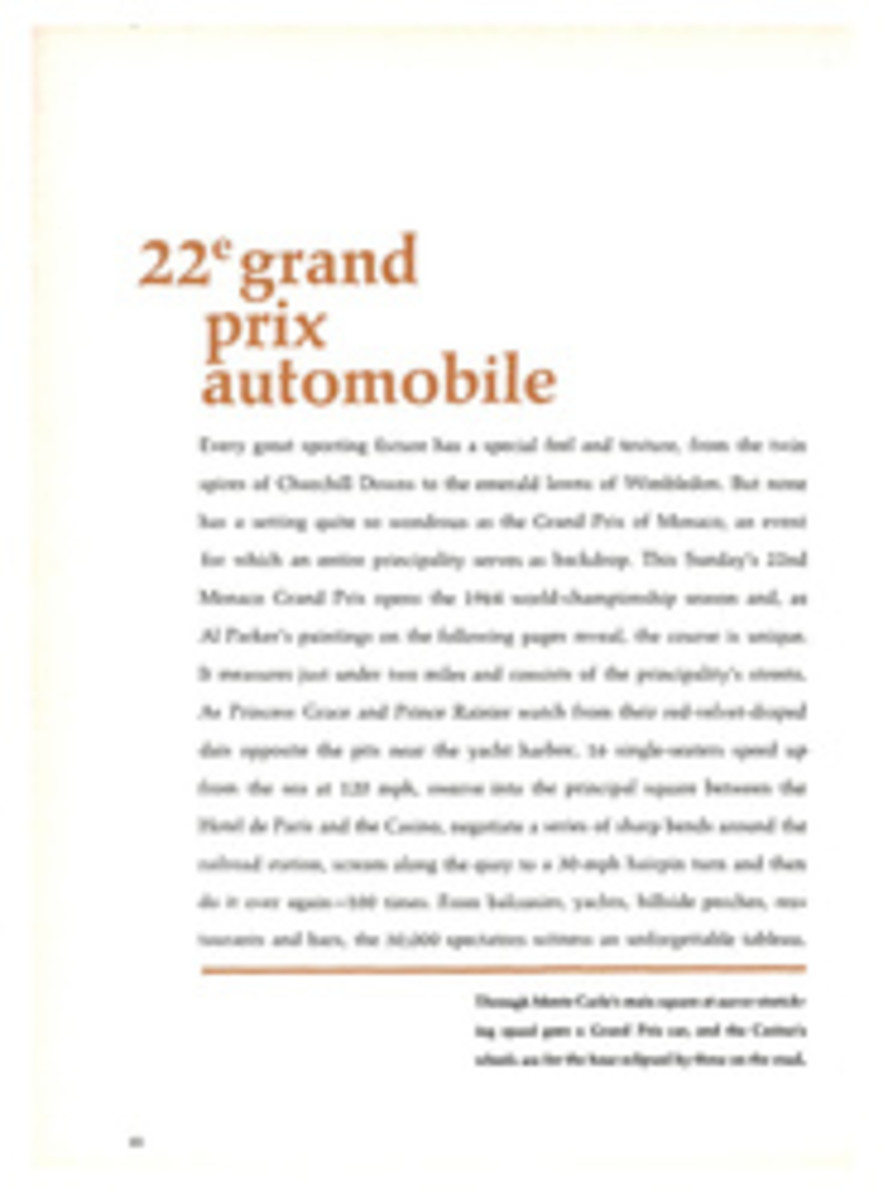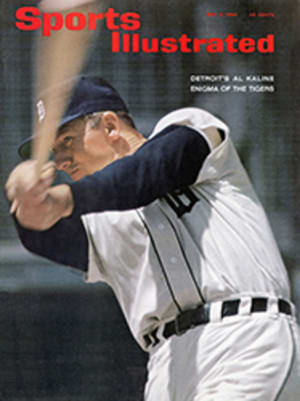
CHAMP OF THE CHOP AND LOOP
For the spectator, top-level competitive table tennis is now all cream. With the introduction of the layered sponge-rubber racket the game has become so fast that it is a sport consisting entirely of the seconds of the windup and the swing in baseball, the pass and the catch in football, of the final determining putts in golf. For the player, it is a game of unremitting tension, and with few exceptions the top men are as jumpy and reactive a lot as you will find.
"It gets so fast," Erwin Klein, the new U.S. Open champion, said last week after winning the title, "that if you wait to see where the ball goes you miss it. You have to anticipate. To play close to the table takes nerve. You give up any advantage of time, so for the most effective shot you draw your opponent in as close as possible so he loses time. Players have developed the game to such a point that often there is no defense; there's no real defense against a ball you can't see."
Erwin Klein is a fine broth of a boy who looks just off a boat from Dublin, but who was in fact just off the freeway from his home in Los Angeles. He has a mop of red hair and the redhead's fair complexion, and at 25 he has surely a greater range of strokes and style of play, and more command of them, than any player in the country. Furthermore, his strokes now include that strategic weapon that was sprung on the U.S. in Prague last year: the loop drive.
The loop is not spectacular. If a man can return it, an untrained eye will never even recognize the shot. But if it is played to an uninstructed opponent, the ball will rise straight off his racket for no apparent reason, if he gets his racket on it at all. If he does not, the ball skids off the table. The loop has to be played off an opponent's chop. The racket is brought up across the ball, so as to accentuate the spin already on it, rather than to counteract or reverse it. After Prague a pair of English table tennis players were imported to teach the loop to the Americans; Klein was out-looping his instructors the first night and beating them both. "And when we go to the World's in Yugoslavia we'll have a couple of new strokes," he says
with the cheerful air of a boy who has been down in the cellar earnestly inventing something that may well blow up the house.
Klein used the loop with total effectiveness on Bobby Fields in their final match for the 34th U.S. Open Table Tennis Championships, held in Ingle-wood, Calif., an L. A. suburb. ("You might say he looped to conquer," a USTTA official chortled.)
The 23-year-old Fields, of Pasadena, is capable of fine table tennis and has got a loop shot himself, but, lean and high-strung, he is not yet on top of his game. He played a handsome semifinal match against Marty Doss of New York and Pasadena, with series after series of ascending long lobs that dropped fatly on the end of the table, forcing Doss to return further lobbable balls until Fields could put one away off a corner. But against the composed and accomplished Klein, who was ranked third to Fields's second, the excitable Fields went down in three brisk games.
Klein's real competition came in the semifinals from the defending champion, Polish-born Bernard Bukiet, now of New York. An impossible 46 years old in a game where the 25-year-old's reflexes may be going, Bukiet is not a man easily rattled, and he is not a man you can defeat with a loop shot; Bukiet does not chop. He plays a tough offensive game, essentially the game that Klein himself would choose. "My most comfortable style," Klein says, "is against someone with whom I can rhythmically exchange drives until I get one I like and put it away. But if Bukiet gets rhythmical, you can't shake him loose. So I tried to change my pace, to force him. I was playing a style that is not my best, but the difference between it and his complement to it was enough for me to win." Klein won 22-20, 21-12, 19-21, 21-12 in a gorgeous four-game match, the best of the three-day tournament.
"People think table tennis is in the wrist," Klein observed afterwards. "Actually it's in the upper legs and the lower back." Along with his range of style and strokes, one should probably take into account the 21 years Klein has on Bernie Bukiet.
It was a smallish gathering at this year's Open, held in the Inglewood High School gymnasium, but the lack of numbers surprised no one familiar with U.S. table tennis. The bulk of the country's players and audience are in the East, along the eastern seaboard or inhabiting a table tennis pocket around Detroit, and they seldom do go west. More to the point, there is not much bulk no matter where you go. Here in the U.S., where we feel fond of, and proprietary about, something we refer to as ping-pong and recall having played in the basement on rainy days, there are just 2,000 registered players and a grand total of 55 registered clubs. This must be compared with 3¼ million registered Communist Chinese players and 300,000 Japanese. The Orientals are the best table tennis players in the world today. On top are the Communist Chinese, with their table tennis academies for promising beginners, the usual Eastern totality of training and their custom of proceeding to tournament sites a month in advance with their own cooks, trainers, et al., to settle down to work. By the time the competition descends, breathless, from the plane, the Chinese are virtually on home ground. Almost as successful are the Japanese, who sometimes even outplan their neighbors. They arrived in Sweden last year, for example, three months early just to practice playing against Swedes. Most of the Chinese and Japanese players use the "penholder" as opposed to the tennis grip on the racket. It is not certain that the grip is better. It is certain that the Easterners practice it more.
Table tennis is China's No. 1 sport, one of Japan's favorites. In Russia table tennis players do calisthenics and road-work. England finds it deplorable that of her many table tennis clubs only 6,600 are affiliated with the ETTA. The ITTF, the international association, comprises 83 member nations (more than any other international sporting federation), and in number of participants the U.S. is one of the smallest.
The fact that most Americans do not really take table tennis seriously has a number of depressing consequences for those who do. The national association has virtually no funds, and helping the best players get around this country to tournaments, let alone around the world, is a continuing struggle. Table tennis clubs, where they do exist, have no more than 20 or 30 members, and do not help much in transporting contestants.
"It's the basements," says J. Rufford Harrison, gloomily. Harrison, four years president of the USTTA and its present recording secretary and most active official, observes, "This is such an infernally rich country that everybody's got a basement and everybody's got a table in it. In England nobody's got a basement, so you have literally thousands of clubs." Klein has said, "In the Orient they have practice during the day and are used to playing at odd hours. An American table tennis player isn't worth a darn until the sun goes down." It should be pointed out that all the tables in all the U.S. basements do not indicate a particular interest in real table tennis. They are the remnants of the 1920's craze for the family game of ping-pong. It is a paradox that today, while billiard academies and bowling lanes have blossomed into shiny respectability, the public table tennis facilities, outside of the clubs and school recreation rooms, have been deteriorating into hangouts that make the old pool halls look like the ladies' aid society.
Along with no money, no clubs and no club spirit, of course, goes no regular competition for the real table tennis player. Table tennis in the Los Angeles and San Diego areas may be on the increase; Erwin Klein can now call to mind three, maybe four, opponents with whom he can practice. Previously there was no chance of working out with his equals, who were in New York, Detroit or the Army. You cannot polish up your loop shot against an auntie whose game is a relic of that fad of the '20s, and the almost total lack of even national competition makes world play just that much more unequal a battle. It represents a considerable triumph that, of the 83 nations, the U.S. men's team is ranked 10th. For three years in a row, 1935, 1936 and 1937, the U.S. men's doubles team took first place in world competition. The best we have done since then are two mixed doubles championships, one in 1947, the other in 1955, and a third in the men's singles in 1959, achieved by the redoubtable Richard Miles, who has been U.S. champion nine times.
The financial difficulties of the USTTA have produced what in other respects must be one of the richest sports associations in the country. "We can afford to make no distinctions," J. Rufford Harrison says contentedly. As a result, there is within the USTTA no amateur or professional category, no shadow of a racial, religious or national bias, and only the most rudimentary provision for recognizing differences of age and sex. The U.S. table tennis team has been competing tranquilly with Communist China for years (or as tranquilly as it can, overmatched as it is). "Of course, there's no such thing as an amateur over there," Harrison points out. "I think Brazil and Japan insist on pure amateurism," he says doubtfully, "and perhaps some others."
The top U.S. players run table tennis clubs, play exhibitions and coach table tennis, and the association rejoices cordially over every penny they earn. As for nationality, you do not have to be a citizen of the U.S. to hold the U.S. championship. Harrison and incoming president Herman Prescott of Newport News, Va. think that the dethroned, Polish-born Bukiet might at some time have taken out citizenship papers, but they are neither of them at all certain. "I'm not a citizen," Harrison, who is English, adds. Prescott is a Negro. And in the Inglewood gym, though attendance was not large, one could hear German, Spanish and English English spoken, and tentative English with Chinese, Japanese, Hungarian, Serbo-Croatian, Polish and New York accents.
Carter Lenoir of Tucson was there. Carter prefers to play in his bare feet, and favors a racket with no rubber on it at all. Judge Alexander came, wearing the polo shirt of the Miami Valley Table Tennis Haven. Walter Alexander is an 81-year-old ex-postal clerk from Cincinnati who does six pushups every morning and has not missed the nationals in 26 years. W. Yee and L. Lee of Vancouver, B.C. were present, happily also in shirts proclaiming them W. Yee and L. Lee, since otherwise, paired in the doubles, they would have been indistinguishable from behind.
The next world championships will be held in Ljubljana, Yugoslavia. Not until 1965, but already J. Rufford Harrison is practicing Serbo-Croatian at lunchtime, Erwin Klein is developing new strokes and Herman Prescott is thinking up ways to get money. Everybody is ready to charge out and get beaten again, but not without honor and a certain élan.
PHOTO
RUSS HALFORD
PHOTO
STOLID NEW YORKER, Bernard Bukiet, lost top ranking when Klein beat him in semifinals.
PHOTO
HIGH-STRUNG CALIFORNIAN, Bobby Fields, ranked second, fell to Klein in finals.

